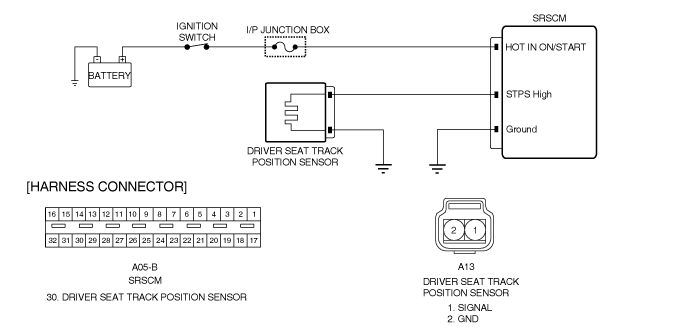STPS located underneath
passenger seat detects horizental position of passenger seat and delivers
it to SRSCM.
Signal of STPS is the
one of major parameters that determine the way dual output type airbag
deploys.
The SRSCM sets DTC B1388
if there is a short to power in Driver STPS harness.
Item
|
Detecting
Condition
|
Possible cause
|
DTC Strategy
|
| •
|
Check current(PWM
type) | |
| •
|
Short to ground in STPS
harness. |
| •
|
Poor connection of connected
part. |
|
Enable Conditions
|
|
Threshold Value
|
|
Diagnostic
Time
|
Qualification
|
|
De-Qualification
|
|
Test Condition
|
Current (A)
|
Ignition ON
|
Rearward :
12 ~ 18mA
Forward : 4 ~
7mA
|

| 1. |
Ignition "OFF", connect
scantool. |
| 2. |
Ignition "ON" & Engine "OFF", select
"Diagnostic Trouble Codes(DTC)"
mode. |
| 3. |
Monitor diagnostic trouble code and present of
trouble code. |
| 4. |
Using a scan tool, clear the DTC.

|
| 5. |
Is DTC present problem ?
|

|
▶ Go to
"W/Harness Inspection" procedure.
|
|

|
▶
Displaying nothing(no DTC) or DTC with label "H"(historical)
shows that Fault is intermittent caused by poor contact in the
part's and/or SRSCM connector or was repaired and SRSCM memory
was not cleared.
Thoroughly check
shorting bar/shorting bar release pin and connectors for
looseness, poor connection, bending, corrosion, contamination,
deterioration, or damage.
▶ Repair
or replace as necessary and then go to "Verification of
Vehicle Repair"
procedure.
|
|
| Terminal and Connector
Inspection |
| 1. |
Many malfunctions in the electrical system are
caused by poor harness and terminals.
Faults can also be caused by interference from
other electrical systems, and mechanical or chemical
damage. |
| 2. |
Thoroughly check connectors for looseness,
poor connection, bending, corrosion, contamination, deterioration,
or damage. |
| 3. |
Has a problem been found?
|

|
▶ Repair
as necessary and then go to "Verification of Vehicle Repair"
procedure.
|
|

|
▶ Go to
"Main harness circuit inspection"
procedure.
|
|
| Main harness Circuit
Inspection |
| 2. |
Disconnect the battery (-) terminal cable from
the battery and wait at least one
minutes. |
| 3. |
Disconnect STPS connector and SRSCM main
harness connector. |
| 4. |
Connect the battery (-) terminal cable to the
battery and Ignition "ON" & Engine
"OFF". |
| 5. |
Measure voltage between terminal "High" of the
STPS harness connector and chassis ground.
Specification : approx.
0V
| |
| 6. |
Is the measured resistance within
specifications?
|

|
▶ Go to
"Component Inspection" procedure.
|
|

|
▶
Substitute the SRS main harness and check for proper
operation.
If the problem is
corrected, replace SRS main harness and then go to
"Verification of Vehicle Repair"
procedure.
|
|
| 1. |
Ignition "ON" & Engine "OFF" and Using a
scan tool, clear the DTC. |
| 3. |
Disconnect the battery (-) terminal cable from
the battery, and wait at least one
minutes. |
| 4. |
Disconnect STPS connector
. |
| 5. |
Substitute the STPS and check for proper
operation. |
| 6. |
Is DTC present problem ?
|

|
▶
Substitute a known-good SRSCM, and check for proper
operation.
If the problem is
corrected, replace SRSCM and then go to "Verification of
Vehicle Repair" procedure.
▶
Substitute the SRS main harness and check for proper
operation.
If the problem is
corrected, replace SRS main harness and then go to
"Verification of Vehicle Repair" procedure.
|
|

|
▶
Substitute a known-good STPS, and check for proper
operation.
If the problem is
corrected, replace STPS and then go to "Verification of
Vehicle Repair"
procedure.
|
|
| Verification of Vehicle
Repair |
After a repair, it is
essential to verify that the fault has been corrected.
| 1. |
Connect scantool and select "Diagnostic
Trouble Codes(DTC)" mode. |
| 2. |
Using a scantool, clear the
DTC. |
| 3. |
Operate the vehicle within DTC Enable
conditions in General information. |
| 4. |
Are any DTC present ?
|

|
▶ Go to the
applicable troubleshooting procedure.
|
|

|
▶ System is
performing to specification at this
time.
|
|